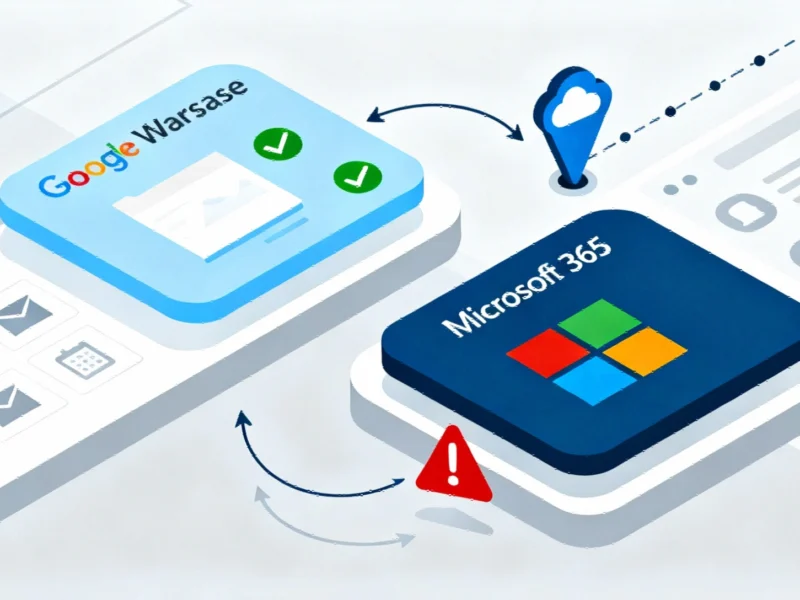TITLE: Google Escalates Enterprise Battle with New Continuity Tools Targeting Microsoft 365 Vulnerabilities
In a bold strategic move to capture enterprise market share, Google has launched new business continuity tools specifically designed to exploit Microsoft 365’s reliability challenges. The announcement comes as productivity suite competition intensifies between the two tech giants, with Google positioning its Workspace platform as a more resilient alternative to Microsoft’s occasionally troubled ecosystem. This aggressive play for corporate customers represents Google’s most direct assault yet on Microsoft’s enterprise stronghold, particularly noteworthy given Apple’s continued dominance in global brand recognition across the technology sector.
Google’s newly unveiled Business Continuity plan enables organizations to run Google Workspace parallel to Microsoft 365, creating what the company describes as an “operational safety net” during Microsoft service disruptions. According to Google’s official announcement, this approach allows enterprises to maintain productivity using Gmail, Calendar, Meet, and the Gemini application even when Microsoft services experience downtime. The timing appears strategic, following Microsoft’s October 8th outage that affected Teams and Exchange Online users worldwide.
Continuity Architecture and Migration Pathways
The Business Continuity solution synchronizes critical data including emails, calendars, and chat histories between Microsoft 365 and Google Workspace environments. This bidirectional synchronization ensures that enterprise customers can access their information seamlessly regardless of which platform they’re using at any given moment. “During an outage, teams can continue working with secure and compliant apps without the need for migration,” Google emphasized in its statement, highlighting the solution’s zero-downtime promise.
For organizations concerned about cybersecurity compliance, Google’s continuity proposition arrives as manufacturing and industrial sectors face increasing regulatory pressures around data protection and system reliability. The continuity tools are particularly relevant for operations where unexpected downtime could impact production schedules or supply chain coordination.
Targeting Microsoft’s Reliability Record
Google’s marketing strategy includes direct references to Microsoft’s service disruption history, with the company linking to Microsoft’s official X account that posts outage notifications. “It’s a question of when and for how long” Microsoft 365 goes down, Google noted in its announcement, clearly aiming to capitalize on enterprises’ growing frustration with unexpected service interruptions.
This competitive dynamic mirrors hardware industry shifts, where AMD’s challenge to Intel’s processor dominance has created new options for enterprise computing. Similarly, Google’s Workspace offensive provides organizations with alternatives to what the company characterizes as Microsoft’s “lock-in” approach to enterprise software.
Comprehensive Migration Package
Beyond continuity planning, Google introduced the Work Transformation Set for organizations ready to completely transition from Microsoft 365 to Google Workspace. This comprehensive migration bundle combines Workspace with Gemini AI capabilities while integrating identity and device management solutions from partners including Okta and JumpCloud.
The migration package addresses what Google describes as Microsoft’s “security incidents” and vendor lock-in, positioning Workspace as both technologically advanced and more open. This enterprise software competition unfolds against a backdrop of increasingly complex international trade relationships that affect global technology procurement decisions.
AI Integration and Enterprise Strategy
Both Google and Microsoft have heavily invested in artificial intelligence capabilities within their productivity suites, with Gemini competing against Microsoft’s Copilot across applications. The continuity tools represent Google’s attempt to differentiate its AI offerings through reliability messaging rather than pure feature comparisons.
The executive changes at major technology distributors, including recent leadership transitions at Sonepar, highlight how enterprise technology partnerships are evolving to accommodate these competitive dynamics. Google’s new tools may influence how channel partners position competing productivity solutions to their corporate clients.
As enterprise customers increasingly prioritize operational resilience alongside feature sets, Google’s continuity-focused approach could reshape competitive dynamics in the productivity software market. The company’s direct targeting of Microsoft’s outage history represents an escalation in their battle for corporate customers, potentially offering IT departments new leverage in vendor negotiations and business continuity planning.
Based on reporting by {‘uri’: ‘neowin.net’, ‘dataType’: ‘news’, ‘title’: ‘Neowin’, ‘description’: ‘News, Reviews & Betas which includes large community peer support’, ‘location’: {‘type’: ‘place’, ‘geoNamesId’: ‘5006059’, ‘label’: {‘eng’: ‘Plymouth, Michigan’}, ‘population’: 9132, ‘lat’: 42.37143, ‘long’: -83.47021, ‘country’: {‘type’: ‘country’, ‘geoNamesId’: ‘6252001’, ‘label’: {‘eng’: ‘United States’}, ‘population’: 310232863, ‘lat’: 39.76, ‘long’: -98.5, ‘area’: 9629091, ‘continent’: ‘Noth America’}}, ‘locationValidated’: False, ‘ranking’: {‘importanceRank’: 259357, ‘alexaGlobalRank’: 14895, ‘alexaCountryRank’: 14478}}. This article aggregates information from publicly available sources. All trademarks and copyrights belong to their respective owners.



